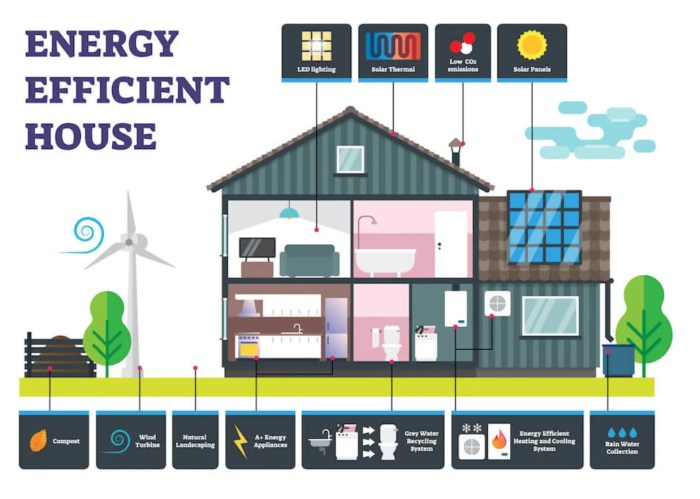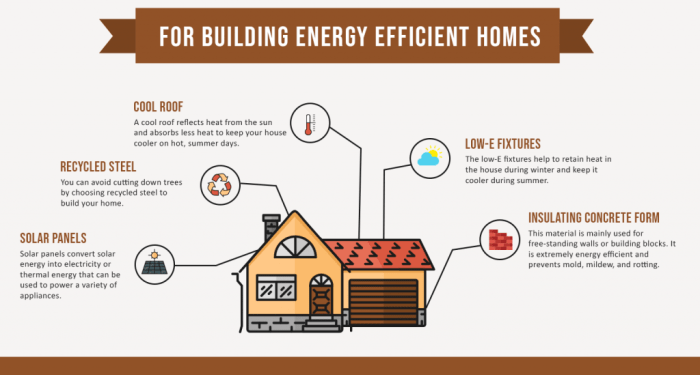Exploring the realm of energy-efficient exterior materials for buildings opens up a world of possibilities for sustainable construction. From innovative materials to cost-effective solutions, this guide delves into the key aspects that define the future of building exteriors.
Types of energy-efficient exterior materials

When it comes to building energy-efficient structures, the choice of exterior materials plays a crucial role in reducing energy consumption and promoting sustainability. Let's explore various types of energy-efficient exterior materials and their benefits in terms of energy efficiency and cost-effectiveness.
Spray Foam Insulation
Spray foam insulation is a popular choice for improving energy efficiency in buildings. It creates an airtight seal, preventing air leakage and reducing heat loss. This material also provides excellent thermal resistance, keeping the indoor temperature stable and reducing the workload on heating and cooling systems.
While the upfront cost of spray foam insulation may be higher, the long-term energy savings make it a cost-effective option for energy-efficient buildings.
Low-E Windows
Low-emissivity (Low-E) windows are designed to minimize heat transfer through windows while still allowing natural light to enter the building. These windows have a thin coating that reflects heat back to its source, keeping the indoor temperature more consistent and reducing the reliance on heating and cooling systems.
Low-E windows help reduce energy consumption and improve overall comfort in the building. Although they may come at a higher cost initially, the long-term energy savings make them a worthwhile investment for energy-efficient buildings.
Green Roofs
Green roofs are another energy-efficient exterior material that offers numerous benefits. They provide natural insulation, reducing heat loss in winter and heat gain in summer. Green roofs also absorb rainwater, reduce stormwater runoff, and create a habitat for wildlife. Additionally, they improve air quality, reduce urban heat island effect, and extend the lifespan of the roof membrane.
While the installation of green roofs may require a higher upfront cost, the long-term benefits in energy savings, stormwater management, and environmental impact make them a sustainable choice for energy-efficient buildings.
Properties of energy-efficient exterior materials
Energy-efficient exterior materials possess key properties that contribute to reducing energy consumption in buildings. These properties not only help in enhancing the overall sustainability of the structure but also play a crucial role in lowering utility costs and minimizing environmental impact.
Thermal Insulation
One of the primary properties of energy-efficient exterior materials is their excellent thermal insulation capabilities. These materials are designed to minimize heat transfer between the interior and exterior of a building, thus reducing the need for excessive heating or cooling.
By effectively trapping heat during winters and blocking heat during summers, energy-efficient materials help in maintaining a comfortable indoor temperature without over-reliance on HVAC systems.
Air Tightness
Energy-efficient exterior materials are known for their high level of air tightness, which prevents air leakage and infiltration. By creating a barrier against drafts and outside air, these materials ensure that conditioned air remains inside the building, leading to reduced energy loss.
This property helps in improving the overall energy efficiency of the structure and enhances indoor comfort levels.
Reflectivity
Another important property of energy-efficient exterior materials is their ability to reflect solar radiation. By choosing materials with high solar reflectance, buildings can reduce heat gain and lower cooling demands, especially in hot climates. Reflective materials help in maintaining lower surface temperatures, thus decreasing the need for air conditioning and improving overall energy performance.
Durability and Low Maintenance
Energy-efficient exterior materials are often designed to be durable and require minimal maintenance over their lifespan. By choosing long-lasting materials that do not deteriorate easily, building owners can avoid frequent repairs or replacements, reducing both costs and environmental impact. The longevity of these materials contributes to sustainable building practices and ensures continued energy efficiency throughout the building's lifecycle.
Installation methods and techniques
Proper installation of energy-efficient exterior materials is crucial to maximizing energy savings and enhancing the overall performance of the building envelope. By following best practices and employing effective techniques, you can ensure airtightness and insulation effectiveness during the installation process.
Sealing gaps and cracks
- Use high-quality sealants and weather-stripping materials to seal any gaps or cracks in the building envelope.
- Pay special attention to areas around windows, doors, and other openings where air leakage is common.
- Consider using expanding foam insulation to fill in larger gaps effectively.
Proper insulation installation
- Install insulation materials correctly according to manufacturer guidelines to achieve optimal thermal performance.
- Avoid compressing insulation material to maintain its effectiveness and prevent thermal bridging.
- Ensure a continuous layer of insulation without any gaps or voids for consistent energy efficiency.
Vapor barrier installation
- Install a vapor barrier on the warm side of the insulation to prevent moisture from entering the building envelope.
- Properly seal and tape the vapor barrier to ensure airtightness and prevent condensation issues.
- Consider the climate and local building codes when selecting and installing vapor barriers for optimal performance.
Environmental impact and sustainability
When considering the environmental impact of using energy-efficient exterior materials in construction, it is important to note that these materials can significantly reduce energy consumption and greenhouse gas emissions. By improving the insulation and air-tightness of buildings, energy-efficient materials help reduce the need for heating and cooling, leading to lower energy bills and a smaller carbon footprint.
Sustainable practices in material selection
Integrating sustainable practices into the selection and use of energy-efficient exterior materials involves considering the entire life cycle of the materials. This includes sourcing materials from environmentally responsible suppliers, choosing materials with high recycled content, and opting for products that can be easily recycled or reused at the end of their life.
Certifications and standards
- One important certification related to the sustainability of energy-efficient exterior materials is the Leadership in Energy and Environmental Design (LEED) certification. This certification evaluates the environmental performance of buildings and encourages the use of energy-efficient materials and practices.
- Another important standard is the Energy Star rating, which identifies products that meet certain energy efficiency criteria set by the Environmental Protection Agency (EPA). Energy Star-rated materials can help reduce energy consumption and lower utility costs.
- Additionally, the Cradle to Cradle certification assesses a product's environmental impact throughout its entire life cycle, from raw material extraction to disposal. This certification promotes the use of materials that are safe for human health and the environment.
Last Point
In conclusion, the use of energy-efficient exterior materials not only benefits the environment but also contributes to long-term cost savings and improved building performance. By choosing the right materials and installation methods, we pave the way for a greener and more efficient future in construction.
Quick FAQs
Are energy-efficient exterior materials more expensive than traditional ones?
While the initial cost may be higher, the long-term savings on energy bills make them a cost-effective choice.
How do energy-efficient exterior materials help in reducing energy consumption?
These materials have properties that improve insulation, reduce heat transfer, and minimize the need for heating or cooling.
What certifications should I look for when selecting energy-efficient exterior materials?
Look for certifications like LEED or Energy Star to ensure the sustainability and energy efficiency of the materials.



